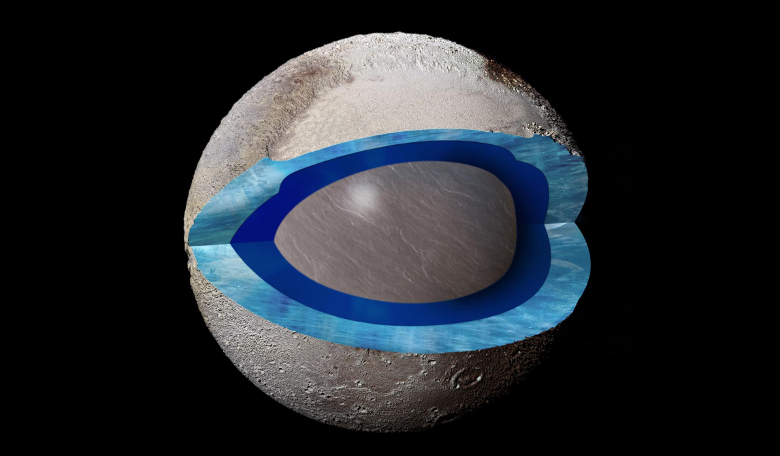It has long been suspected that beneath Pluto's "heart" lies a subsurface ocean, now according to a new study using data from NASA's New Horizons spacecraft, researchers from MIT suggest that this indeed the case.
Analysis of the data suggests that the dwarf planet's most prominent surface feature – a heart-shaped region named Tombaugh Regio – is hiding a cold, slushy ocean of water ice just below its surface that has strong links with the evolution of key features such as the vast, low-lying basin known as Sputnik Planitia (formerly Sputnik Planum) on the heart’s western lobe.
Tombaugh Regio, which is Pluto's brightest region, has puzzled astronomers for a number of years as it aligns almost exactly opposite from the dwarf planet's moon, Charon, in a locked orientation and why this should be, has so far lacked a convincing explanation. However this new data suggests that a thick, heavy ocean may serve as a "gravitational anomaly," or weight, which has provided an anchor in Pluto and Charon's gravitational tug-of-war.
It is thought, that like other large basins in the solar system, that Sputnik Planitia was formed by the impact of a giant meteorite, which would have blasted away a huge amount of Pluto's icy crust. As the object impacted the surface, if a subsurface ocean existed, it would create an upwelling of water that pushing up against the thinned and weakened crust of ice. At equilibrium, because water is denser than ice, that would still leave a fairly deep basin with a thin crust of ice over the upwelled mass of water.
"At that point, there is no extra mass at Sputnik Planitia," explained Francis Nimmo, professor of Earth and planetary sciences at UC Santa Cruz and first author of a paper published in Nature. "What happens then is the ice shell gets cold and strong, and the basin fills with nitrogen ice. That nitrogen represents the excess mass."
Nimmo and colleagues considered other ways in which to provide enough mass in order to create a "positive gravity anomaly" consistent with the observations, however none of them looked as likely as a subsurface ocean. "There's plenty of nitrogen in Pluto's atmosphere, and either it preferentially freezes out in this low basin, or it freezes out in the high areas surrounding the basin and flows down as glaciers," Nimmo said. This is seen in images from New Horizons which appear to show nitrogen glaciers flowing out of mountainous terrain around Sputnik Planitia.
"Pluto is hard to fathom on so many different levels," says New Horizons co-investigator Richard Binzel, professor of earth, atmospheric and planetary sciences at MIT. Binzel is also a joint professor of aerospace engineering and a faculty affiliate with the MIT Kavli Institute. "People had considered whether you could get a subsurface layer of water somewhere on Pluto. What's surprising is that we would have any information from a flyby that would give a compelling argument as to why there might be a subsurface ocean there. Pluto just continues to surprise us."











